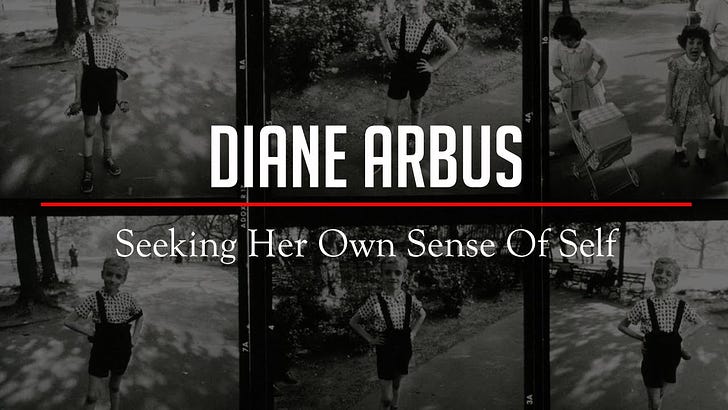DIANE ARBUS: Where Art Meets Mental Health
Complicated family dynamics, history of depression, multilayered sexuality, and other things that may have helped shape the direction of the photographer's creativity
In these essays, I looked at the relationship of art and mental health for photographer Diane Arbus. Click on each one to go to the full essays …
Diane Arbus' Risk-Taking Behavior Resulted In A Legacy of Outstanding Photographs ... Was It Motivated By Depression?
Diane Arbus had documented periods of depression as early as age 11. Her mother also suffered from depression, so there might be a genetic and/or an intergenerational trauma component to her condition. Biographers and scholars have speculated about the possible influence of bipolar disorder on her behavior, citing manic episodes and impulsive tendencies. If it’s true that she lived with unipolar (major) depression and further if it’s true that she was unusually sexual (again, take that with a grain of salt) and that she pursued her art in situations that felt dangerous to her, there could be another explanation: perhaps Arbus was simply trying to feel something.
The Complicated Family Dynamics in the Life and Work of Diane Arbus
I want to return to the book chapter that I wrote and the discussion of Diane Arbus’s sexuality. More specifically, I want to turn to the way that fuzzy boundaries in her family of origin might have potentially impacted her mental health and her art.
In Woman on a Park Bench on a Sunny Day, did Diane Arbus Capture the Essence of Depression in Another Woman?
Woman on a Park Bench on a Sunny Day, is a photograph that Diane Arbus took in 1969, the same year that she started her final series featuring institutionalized women. On the surface, the woman pictured here couldn’t be more different from those women. This perfectly coiffed socialite is poised on a park bench, pearls around her neck, a stark contrast to the women with mental challenges who we picture in an institution. The dichotomy represents the two different sides of Arbus: the wealthy woman who ran in circles of elite people and the woman who didn’t feel like she fit in there and sought out the world’s misfits.
Looking: Diane Arbus' Depictions of Disability, Neurodiversity and "Difference"
I want to share with you some quotes/excerpts/thoughts from others about how the photographs that she took represent disability, neurodiversity, mental health challenges, and “difference”. My hope is that these excerpts from others might expose you to works of Diane Arbus that you don’t know and/or provide insights into the way that she depicted people that go beyond what I’ve already shared in the previous posts in this series.
The Most Interesting Work I Found Inspired By Diane Arbus
The work that I’m doing in this world is to research the nuances of the relationship between art and mental health so that we can move away from exactly these tropes of the suffering genius and get into the shades of gray about what that really means. So I appreciate the playwright’s goal not to shy away from the pain in Diane Arbus’s psyche but also not to center that in some idealized way.
If you read this far, perhaps you liked the work. The work does take work. It only continues with support, so please consider subscribing. My annual rate starts at $10 per year.











